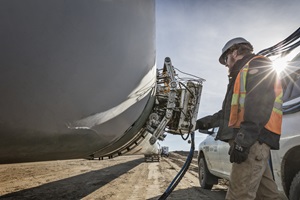Maximize Efficiency: Proactive Pipeline Welding Inspection Strategies
Maximize Efficiency: Proactive Pipeline Welding Inspection Strategies
Blog Article
Comprehensive Summary of Pipe Welding Inspection Treatments
Pipe welding assessment procedures play an essential function in ensuring that welded links satisfy strict market criteria and requirements. From precise pre-welding evaluations to comprehensive post-weld assessments, a distinct evaluation procedure is necessary for maintaining the structural stability of pipelines.
Pre-welding Inspection Preparations
Before beginning the welding process, thorough pre-welding examination preparations are necessary to guarantee the integrity and quality of the weld joint. These preparations include a meticulous assessment of the materials to be welded, the welding tools, and the work environment. By performing extensive pre-welding evaluation preparations, prospective concerns can be recognized and resolved early on, leading to trusted and high-grade weld joints.
Welding Procedure Certification
Comprehensive pre-welding examination prep work lay the structure for the crucial process of Welding Treatment Certification, guaranteeing the honesty and high quality of the weld joint. Welding Procedure Qualification (WPQ) is an essential action in the welding procedure that includes screening and licensing welding treatments to assure they satisfy certain requirements and needs. The WPQ procedure generally includes welding procedure requirements development, welding treatment credentials testing, and documents of the outcomes.
Throughout welding treatment spec growth, necessary information such as the welding process, welding products, joint design, and welding criteria are defined to develop a comprehensive treatment. Ultimately, welding treatment qualification testing is performed to verify the proposed procedure's integrity. This testing usually includes welding test vouchers that go through numerous mechanical and non-destructive tests to analyze the weld's quality and adherence to the defined criteria.
In-process Weld Inspection
Throughout the welding procedure, in-process weld examination plays an important role in guaranteeing the top quality and integrity of the weld joint - Pipeline Welding Inspection. This sort of assessment includes keeping track of the welding parameters, evaluating the weld bead development, and spotting any prospective problems or discontinuities as they take place. By carrying out in-process weld evaluations, welding operators can quickly resolve any problems that might develop, thereby guaranteeing and stopping more flaws that the final weld satisfies the called for specifications
Common methods used for in-process weld assessment include aesthetic evaluation, fluid penetrant screening, magnetic bit screening, ultrasonic testing, and radiographic testing. Overall, in-process weld assessment is necessary for preserving the quality and dependability of welded pipelines.
Non-destructive Testing (NDT)
Non-destructive Testing (NDT) is a crucial method used in pipeline welding evaluation to assess the honesty of weld joints without causing damage to the bonded framework. By utilizing different NDT strategies, examiners can review the top quality of welds and recognize any defects or interruptions that may endanger the structural soundness of the pipeline. Usual NDT approaches used in pipeline welding evaluation include Radiographic Testing (RT), Ultrasonic Screening (UT), Magnetic Particle Evaluating (MPT), Liquid Penetrant Screening (LPT), and Visual Screening (VT)
RT includes making use of X-rays or gamma rays to generate images of the interior structure of the weld, allowing assessors to spot issues such as porosity, fractures, or incomplete fusion. UT uses high-frequency acoustic waves to discover flaws beneath the surface area of the weld, supplying comprehensive info about the size and place of flaws. MPT and LPT are utilized to identify surface-breaking problems by using magnetic fragments or penetrant liquids to the weld location. Additionally, VT involves aesthetic inspection of welds her latest blog to determine any kind of noticeable flaws.
Post-weld Evaluation and Documentation


Documentation of post-weld examination findings is necessary for preserving quality assurance records and making certain compliance with industry criteria and laws. In-depth records should consist of information about the assessment click for more methods made use of, the location and nature of any kind of issues located, and any type of restorative activities taken - Pipeline Welding Inspection. Proper paperwork not just serves as a document of the weld's top quality however likewise help in future upkeep and examination processes
Conclusion

To conclude, pipe welding evaluation procedures play a vital duty in ensuring the high quality and integrity of welds. From pre-welding assessments to post-weld documentation, each action is crucial in preserving the security and efficiency of pipelines. By following recognized treatments and performing detailed inspections, potential flaws can be recognized and addressed prior to they bring about pricey repair Go Here services or failings. On the whole, adherence to appropriate examination methods is essential to the success of pipeline welding tasks.
From thorough pre-welding examinations to detailed post-weld assessments, a well-defined evaluation procedure is vital for maintaining the architectural soundness of pipelines. By carrying out in-process weld assessments, welding operators can without delay deal with any concerns that might emerge, thereby avoiding further defects and ensuring that the last weld meets the called for requirements.
Typical methods utilized for in-process weld examination include visual assessment, liquid penetrant testing, magnetic bit testing, ultrasonic screening, and radiographic testing.Non-destructive Testing (NDT) is a critical technique employed in pipeline welding examination to examine the integrity of weld joints without triggering damage to the bonded structure. Post-weld evaluation involves different methods to analyze the welds for flaws, including aesthetic examination, color penetrant screening, magnetic particle screening, ultrasonic testing, and radiographic testing.
Report this page